Seasons and Weather季节与天气
- 格式:ppt
- 大小:3.87 MB
- 文档页数:25
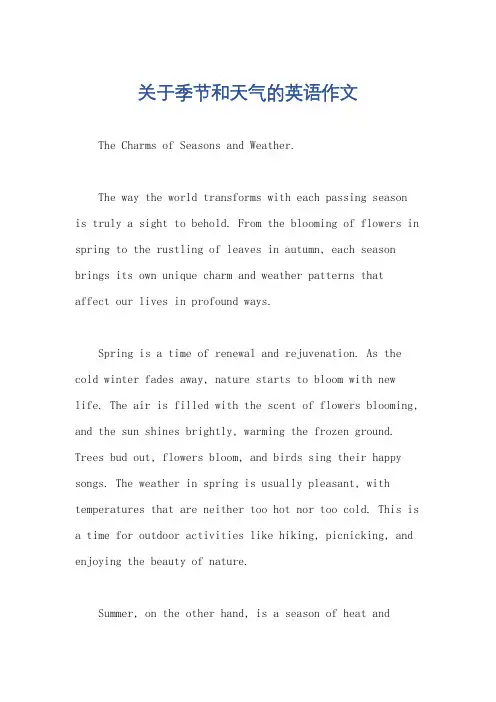
关于季节和天气的英语作文The Charms of Seasons and Weather.The way the world transforms with each passing season is truly a sight to behold. From the blooming of flowers in spring to the rustling of leaves in autumn, each season brings its own unique charm and weather patterns thataffect our lives in profound ways.Spring is a time of renewal and rejuvenation. As the cold winter fades away, nature starts to bloom with new life. The air is filled with the scent of flowers blooming, and the sun shines brightly, warming the frozen ground. Trees bud out, flowers bloom, and birds sing their happy songs. The weather in spring is usually pleasant, with temperatures that are neither too hot nor too cold. This is a time for outdoor activities like hiking, picnicking, and enjoying the beauty of nature.Summer, on the other hand, is a season of heat andenergy. The sun shines brightly, and the temperatures can often be sweltering. This is a time for activities that involve being outdoors, such as swimming, beach visits, and barbecues. The weather in summer can also be unpredictable, with thunderstorms and showers breaking out suddenly. These storms bring a welcome break from the heat and often leadto beautiful sunsets.Autumn is a time of transition and reflection. The leaves change color, turning a riot of reds, oranges, and yellows. The air is crisp and cool, and the sun shines with a gentle warmth. This is a time for walks in the woods, enjoying the rustling of leaves underfoot and the beauty of falling leaves. The weather in autumn is usually pleasant, with temperatures that are neither too hot nor too cold, making it a great time for outdoor activities.Winter is a time of rest and rejuvenation. The snow covers the ground, and the air is filled with a crisp chill. The weather in winter can be extreme, with heavy snowfall and cold temperatures. This is a time for indoor activities like curling up with a good book, watching movies, or goingfor winter sports like skiing and snowboarding. The beauty of snow-covered landscapes and the quietness of winter nights add to the charm of this season.The changes in weather patterns throughout the year also affect our daily lives. The rain brings moisture to the soil, promoting the growth of plants and crops. The sun provides us with vitamin D and helps regulate our circadian rhythms. The cold winter months encourage us to stay indoors, while the warm summer days invite us to explore the outdoors.In conclusion, the seasons and their associated weather patterns play a crucial role in shaping our lives. They bring about changes in nature, affect our mood and activities, and add to the beauty and diversity of the world we live in. As the seasons change, so do our lives, and it is this constant flux that makes life so exciting and unpredictable.。

Module8 Seasons and WeatherUnit 1 It's hot in summer.蔡雪芹本课是《新标准英语》三年级起点第二册第八模块第一单元:《It’s hot in summer》,学生要学习并掌握季节和天气的单词,并通过一系列的课堂活动,创造语境,让学生把单词运用于句子中,学会用天气的单词描述季节,并介绍在该季节中适合进行的活动。
教学目标:1、知识目标:能听、说、读本节课的新单词、新句型。
2、情感目标:在语言教学中培养学生热爱生活,热爱大自然,积极乐观的生活情感态度。
3、能力目标:在语言教学中培养学生探究、自主、合作的学习方法以及在实际生活中运用语言的能力。
教学重点:学习认识有关季节和天气的单词spring, summer, autumn, winter, warm, hot, cool, cold.掌握It’s spring. It’s warm in sprin g. We fly kites in spring.等新句型。
教学难点:句型在生活中的灵活运用。
Teaching steps:(教学步骤)Step One: Warm up(课前热身)1、GreetingLet’s sing a chant.一年有四季春夏秋冬要分清spring spring 春天到,百花开鸟儿叫summer summer夏天到,烈日炎炎当头照autumn autumn秋天到,红红的苹果点头笑winter winter冬天到,北风吹来雪花飘warm 温暖春天天气暖洋洋hot 炎热夏天天气真炎热cool 凉爽秋天天气多凉爽cold 寒冷冬天天气冷又寒春天spring warm 温暖夏天summer hot 炎热秋天autumn cool 凉爽冬天winter cold 寒冷2.T: Very good,歌谣里面出现的英语单词你们记住了吗?Do you remember?Ss: Yes!师利用单词卡片检查4个季节单词的发音,然后英汉互译再次检查,速度要快。
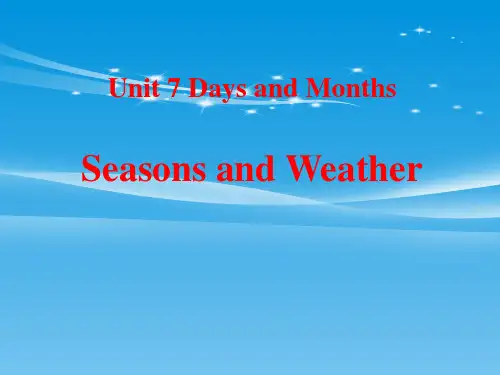


小升初英语作文季节与天气题目,Seasons and Weather。
Weather and seasons play an essential role in our lives. They not only affect our daily activities but alsoinfluence our moods and health. In this essay, we will explore the different seasons and their associated weather conditions.Spring is a season of rebirth and renewal. It is characterized by mild temperatures, blooming flowers, and chirping birds. The weather in spring can be unpredictable, with occasional rain showers and fluctuating temperatures. However, it is generally a pleasant time of year, as nature awakens from its winter slumber.Summer is a season of warmth and sunshine. The weatheris typically hot and humid, with clear skies and long days. It is the perfect time for outdoor activities such as swimming, hiking, and picnicking. However, summer can alsobring extreme heatwaves, which can be dangerous if proper precautions are not taken.Autumn, or fall, is a season of transition. The weather becomes cooler, and the days grow shorter. The leaves on the trees change color, creating a beautiful display of reds, oranges, and yellows. Autumn is also harvest season, with farmers gathering crops such as apples, pumpkins, and corn. The weather in autumn can be unpredictable, with sunny days followed by chilly nights.Winter is a season of cold and snow. The weather is often harsh, with freezing temperatures and snowfall. Winter sports such as skiing, snowboarding, and ice skating are popular activities during this time of year. However, winter can also bring hazardous conditions such as icy roads and blizzards, making travel difficult.In conclusion, weather and seasons have a significant impact on our lives. Each season brings its own unique weather conditions, which can affect everything from our daily activities to our mood and health. By understandingand adapting to the weather, we can make the most of each season and enjoy all that nature has to offer.。

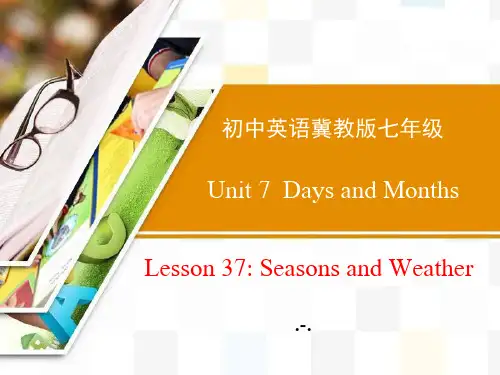

天气和季节的描述英语作文Title: Describing Weather and Seasons in English。
Weather and seasons play a crucial role in shaping our daily lives and activities. In this essay, we will explore various aspects of weather and seasons, their impacts, and how we can describe them effectively in English.Weather, the atmospheric conditions prevailing at a particular time and place, encompasses elements such as temperature, humidity, precipitation, wind speed, and atmospheric pressure. It greatly influences our daily routines, outdoor activities, and even our moods. Describing weather accurately requires a rich vocabulary and an understanding of various weather phenomena.Let's start with the four main seasons: spring, summer, autumn (fall), and winter. Each season brings distinct weather patterns and changes in the environment.Spring is characterized by moderate temperatures, blooming flowers, and rejuvenation in nature after the cold winter months. The weather is often mild, with occasional rain showers. People describe spring as a time of renewal and growth.Summer is typically the hottest season of the year, with long days and warm nights. The sun shines brightly, and temperatures can soar, especially in regions with a continental climate. People enjoy outdoor activities like swimming, hiking, and picnics during this time.Autumn, also known as fall, marks the transition from summer to winter. The weather becomes cooler, and leaves on deciduous trees change color and eventually fall. Autumn is often associated with harvest festivals, pumpkin patches, and cozy evenings by the fireplace.Winter is characterized by cold temperatures, snowfall, and shorter days. In colder regions, lakes freeze over, and snow blankets the landscape, creating a winter wonderland. People engage in activities like skiing, snowboarding, andbuilding snowmen during this season.Now, let's delve into describing specific weather conditions in English:1. Clear and Sunny: When the sky is clear and the sunis shining brightly, we describe it as a sunny day. Phrases like "blue skies," "bright sunshine," and "warm rays of the sun" can be used to vividly portray such weather conditions.2. Cloudy: When the sky is covered with clouds,blocking the sun, we describe it as cloudy weather. Phrases such as "overcast skies," "cloudy with a chance of rain," and "gray clouds looming overhead" help convey this atmosphere.3. Rainy: Rainy weather brings precipitation in theform of raindrops falling from the sky. We can describe it as "rainy," "showery," or "drizzling." Words like "pitter-patter of raindrops," "rain-soaked streets," and "umbrellas unfurled" paint a picture of a rainy day.4. Snowy: Snowfall transforms the landscape into a winter wonderland. Descriptive phrases such as "blanket of snow," "flurries in the air," and "frosty temperatures" capture the essence of snowy weather.5. Windy: Windy weather is characterized by strong gusts of wind blowing through the air. We can describe it as "blustery," "wind-whipped," or "breezy." Phrases like "trees swaying in the wind," "howling winds," and "wind chill factor" help illustrate windy conditions.6. Foggy: When dense fog obscures visibility, we describe it as foggy weather. Words like "thick fog," "misty morning," and "visibility reduced to a few feet" convey the atmospheric conditions associated with fog.7. Stormy: Stormy weather brings thunderstorms, lightning, and heavy rainfall. Descriptive phrases such as "rumble of thunder," "flashes of lightning," and "torrential downpour" paint a vivid picture of stormy conditions.In conclusion, weather and seasons provide a rich tapestry of experiences and moods throughout the year. By mastering descriptive language and vocabulary related to weather, we can effectively communicate and express our observations and experiences in English. Whether it's a sunny day in summer or a snowy evening in winter, the language allows us to capture the essence of the weather and seasons with clarity and precision.。
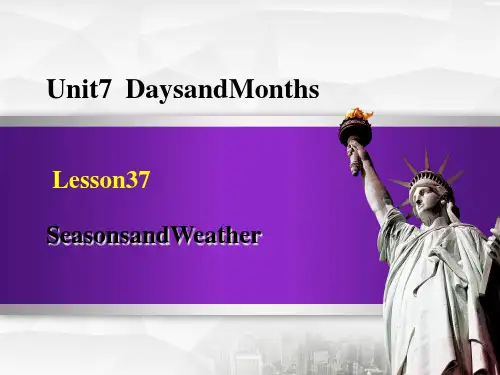
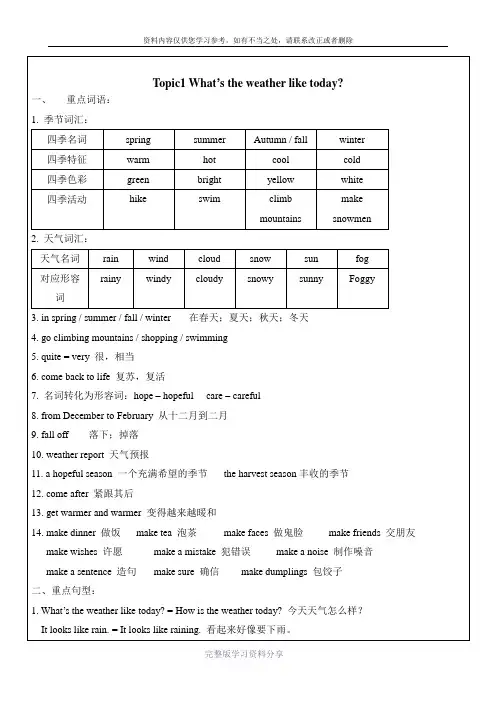
D. Monday and Wednesday( )28. It is ______ on Friday, May 2nd.A. sunny all day w W w .x K b 1.c o MB. cold and windy all dayC. sunny in the morning but cloudy in theafternoonD. rainy in the morning and cold in the afternoon( )29. Which day has a sunny morning and a cloudyafternoon?A. Thursday.B. Monday.C. Saturday.D. Friday.( )30. Wang Jian flew his kite on a day that waswindy in the morning but rainy in theafternoon. He may do this on _____.A. Monday, April 28thB. Saturday, April 26thC. Thursday, May 1stD. Tuesday, April 29th(B)In China, the best months of the year are October and November. At this time the sun shines brightly and often wind blows to keep the temperature down. The weather is never too cold or too hot. The temperature is usually between 16℃and 22℃.In winter, wind blows strongly and the temperature falls. By January and February the temperature falls to its lowest, sometimes under zero. It seldom rains. In March and April, the temperature goes up, and there is often fog and light rain. It gets warm in May and June, but it’s not too hot. There is often heavy rain in June and sometimes it rains for three or four days.July and August are the hottest(最热的)months. It often rains hard until late August. The average(平均的)temperature is 33℃. In September the temperature begins to fall. The highest temperature is near 29℃.根据短文内容,选择正确答案。
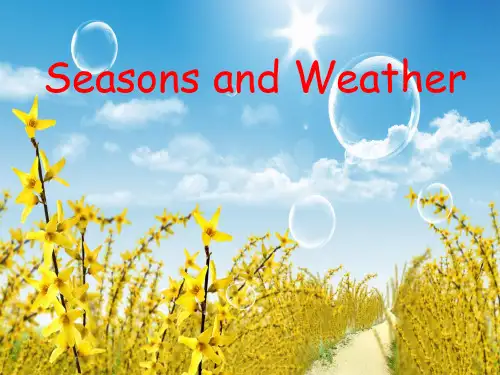
季节与天气英语作文Title: Seasons and Weather。
Weather and seasons play a significant role in shaping our daily lives and influencing various aspects of human activities. In this essay, we will delve into the characteristics of different seasons and their corresponding weather conditions.Firstly, let's discuss spring. Spring is a season of renewal and rebirth. It typically occurs between March and May in the Northern Hemisphere. During spring, the weather gradually warms up, and nature comes back to life after the cold winter months. The days become longer, and flowers begin to bloom, filling the air with their fragrant scent. Spring weather can be quite unpredictable, with sudden rain showers and occasional thunderstorms, but overall, it's a pleasant season characterized by mild temperatures and vibrant colors.Moving on to summer, which is often associated with warmth and sunshine. Summer spans from June to August in the Northern Hemisphere. It is the hottest season of the year, with temperatures soaring and the sun shining brightly. People often flock to beaches, lakes, and pools to cool off from the sweltering heat. Summer is also a time for outdoor activities such as hiking, picnicking, and barbecuing. However, summer weather can sometimes be extreme, leading to heatwaves and droughts in certain regions.Next, let's explore autumn, also known as fall. Autumn occurs between September and November in the Northern Hemisphere. It is a season of transition, as the days become shorter, and the temperatures start to drop. The leaves on trees change color, painting the landscape with hues of red, orange, and yellow. Autumn weather is characterized by crisp mornings and cool evenings, making it the perfect time for cozy sweaters and hot beverages.It's also a season for harvest festivals and gatherings with family and friends.Lastly, we come to winter, the coldest season of the year. Winter typically spans from December to February in the Northern Hemisphere. During winter, temperatures plummet, and snowfall becomes common in many regions. It's a time when people bundle up in layers of clothing and gather around fireplaces to stay warm. Winter sports such as skiing, snowboarding, and ice skating are popular activities during this season. However, winter weather can also bring challenges such as icy roads and blizzards, making travel difficult.In conclusion, weather and seasons have a profound impact on our lives, influencing everything from our clothing choices to our recreational activities. Each season brings its own unique charm and beauty, from the blossoms of spring to the snowflakes of winter. By embracing and adapting to the changing weather patterns, we can fully appreciate the wonders of nature throughout the year.。
五年级上册英语教案-Unit 1 Seasons and Weather 广东开心英语(粤人版)教学内容本单元主要围绕“季节与天气”这一主题,教授学生如何用英语描述不同的季节和天气状况。
教学内容包括四季的英文名称(spring, summer, autumn, winter),以及常见天气状况的表达(sunny, cloudy, rainy, windy)。
此外,还将教授学生如何用英语讨论个人对于不同季节和天气的喜好。
教学目标1. 知识与技能:学生能够正确识别并说出四季的英文名称,并能用英语描述不同季节的天气特点。
2. 过程与方法:通过观察、讨论和实践,学生能够运用英语表达个人对季节和天气的喜好。
3. 情感态度价值观:培养学生对自然环境的关注和热爱,增强学生用英语进行日常交流的信心。
教学难点1. 正确区分并运用不同的天气状况词汇。
2. 运用英语描述季节变换对个人活动的影响。
3. 构建简单的英语句子来表达对季节和天气的喜好。
教具学具准备1. 多媒体课件:展示四季图片和相应的天气状况。
2. 四季和天气的单词卡片。
3. 学生活动手册。
4. 彩色笔和画纸(用于学生制作季节画)。
教学过程1. 导入:通过展示不同季节的图片,引导学生用中文描述各自喜欢的季节,并简单说明原因。
2. 新授:介绍本节课的主要词汇和句型,使用多媒体课件辅助教学,让学生跟读并模仿。
3. 实践:分组练习,让学生在小组内用英语讨论各自喜欢的季节和天气,并汇报给全班。
4. 巩固:进行“我说你猜”的游戏,巩固对季节和天气词汇的记忆。
5. 小结:总结本节课学习的内容,强调重点词汇和句型。
6. 作业布置:要求学生回家后,用英语向家人描述一个自己喜欢的季节,并说明理由。
板书设计板书将围绕四季的名称和天气状况展开,每个季节旁边配有代表性的天气词汇。
同时,将用不同颜色的粉笔区分季节和天气词汇,以便学生更好地记忆和区分。
作业设计1. 书面作业:完成活动手册上的相关练习,包括填空、选择和简单句子构造。
季节和天气的区别英语作文Seasons and Weather。
The four seasons of the year bring different weather patterns and changes in the environment. Each season hasits unique features that distinguish it from the others. This essay will discuss the differences between the seasons and the weather associated with them.Spring is the season of new beginnings. The weather is mild, and the days begin to get longer. Flowers start to bloom, and trees grow new leaves. The temperature is usually between 10 to 20 degrees Celsius, and it can be rainy at times. Spring is a great time to enjoy outdoor activities, such as hiking, picnicking, and gardening.Summer is the hottest season of the year. The temperature can range from 25 to 40 degrees Celsius, depending on the location. The days are longer, and the sun is stronger. People wear lighter clothes and spend moretime outside. Summer is the perfect time for swimming, sunbathing, and playing sports.Fall, also known as autumn, is the season of change.The leaves on the trees change color and fall to the ground. The temperature begins to drop, and the days become shorter. The weather can be unpredictable, with rain and windstorms. Fall is a great time to enjoy the beautiful scenery and go for walks in the park.Winter is the coldest season of the year. The temperature can drop below freezing, and snow can cover the ground. The days are shorter, and the nights are longer. People wear heavy coats, hats, and gloves to keep warm. Winter is a great time for skiing, snowboarding, and ice skating.In conclusion, the seasons and weather patterns are constantly changing, and each one has its unique features. Spring is the season of new beginnings, summer is thehottest season of the year, fall is the season of change, and winter is the coldest season of the year. It isimportant to enjoy each season and take advantage of the activities that come with them.。